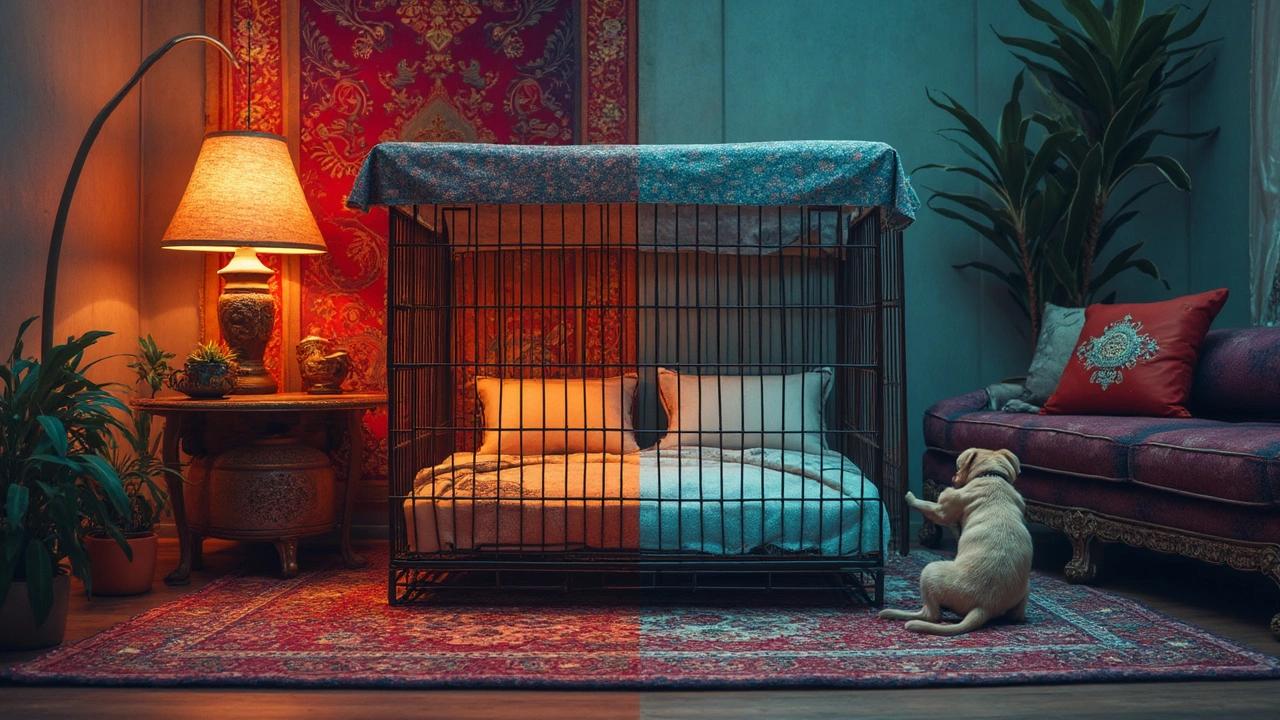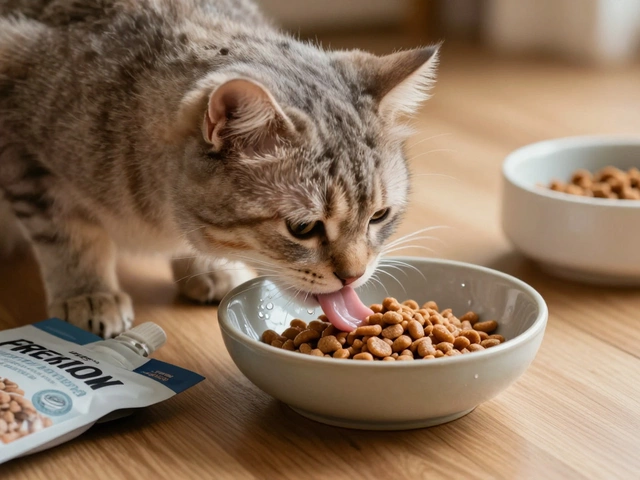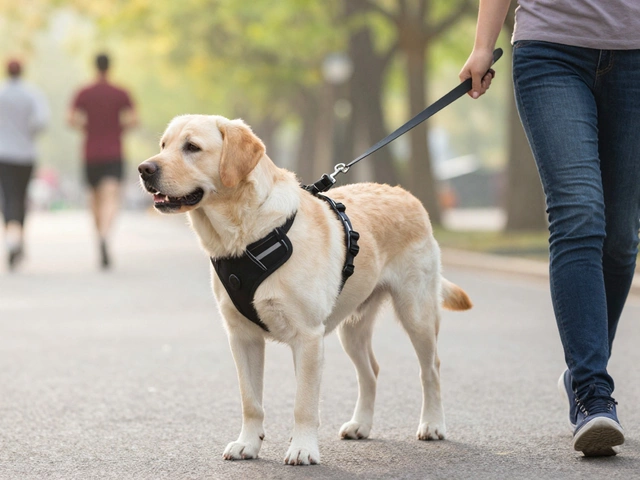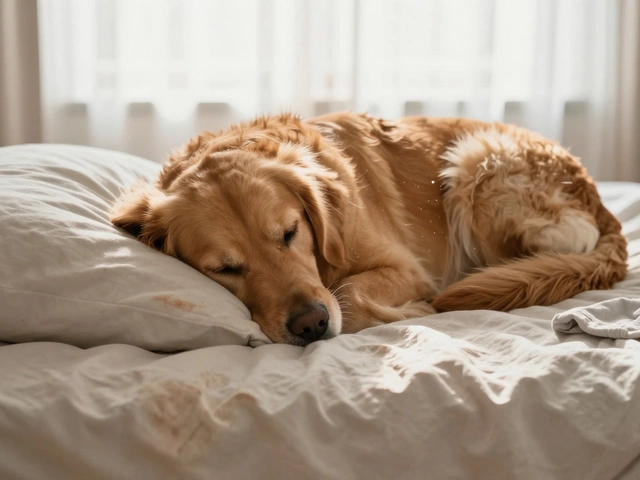
So, you've probably wondered if tossing a blanket over your dog's crate is a good move, right? Well, let's jump into it. Dogs, by nature, dig cozy nooks—it reminds them of their wild ancestors who lived in dens. Covering the crate can simulate that cozy, secure feeling. But does every dog love the idea?
First, understand that covering a crate isn't one-size-fits-all. Some dogs find it comforting, while others might feel trapped. A blanket can help block light and noises, making it easier for puppies to settle down for the night. This can be especially helpful for those who get restless or have trouble snoozing in a busy household.
However, keep an eye on your dog's body language. If they're whining or trying to escape, it might not be their jam. Pay attention to their reaction during the first few tries.
- Creating a Den-Like Environment
- Benefits of Crate Covering
- Potential Downsides
- Understanding Your Dog's Preferences
- Safety Tips for Blanket Use
- Alternatives to Blankets
Creating a Den-Like Environment
Dogs love cozy spaces, and creating a den-like environment with a dog crate can be super chill for your pup. In the wild, dogs' ancestors used dens as safe spots to sleep and hide from predators. Bringing this idea to your home might just make your furry friend feel extra secure.
Think of the crate as your dog's little bedroom. A blanket draped over the top can help mimic that tucked-away den feeling. This helps especially if your house is noisy or full of distractions, allowing your puppy to wind down more easily for a chilled-out night. But wait, there's more to it than just comfort.
Benefits of Den-Like Spaces
Here’s the deal: a covered crate gives a sense of security which can help reduce anxiety in some pups. That dark, enclosed spot can cut out visual distractions, making it easier for your dog to relax. Plus, it might remind your pup that it's time to sleep, kind of like how blackout curtains work for us.
- Puppy care tip: Use breathable fabric when covering the crate to keep things well-ventilated.
- Ensure some airflow by leaving one side uncovered or partially draped.
- Introduce the cover gradually to make sure your dog adjusts comfortably without stress.
Remember though, not every dog has the same taste in relaxation spots. Keep an eye on how your pup reacts. If they seem uneasy or stressed, it might not be the ideal setup for them. Creating that perfect den-like environment is about tuning into what your dog loves and feels most at ease with. So, be attentive and flexible to their needs.
Benefits of Crate Covering
Imagine trying to catch some Zs in a room with constant noise and flashing lights. Not fun, right? Covering your dog's crate acts as a barrier against these disturbances, making it a cozy spot for your furry friend to relax. It's like closing the curtains for dogs, creating a quiet, dark space that can help them feel secure.
One big plus is that it can help reduce anxiety. If your pup gets jumpy or spooked easily, a covered crate can serve as a safe haven. Dogs who've had a rough start or are naturally nervous may feel calmer with a blanket cover because it limits visual stimuli, helping them chill out.
Temperature Control
Blanket-covered crates can also provide a bit of extra warmth during chilly nights. Think of it like tucking your pooch into a snug bed. Of course, don't overdo it in hot weather. Keep an eye on the room temperature and make sure your pup isn't overheating.
Encouraging Sleep
The dark, quiet environment that a blanket creates can encourage better sleep patterns. This is especially helpful for puppies who are still adjusting to a new routine. A well-rested pup is generally happier and easier to train.
Some owners have even noticed improved behavior with a covered crate. Without outside distractions, dogs can learn to settle down quicker, helping to create a peaceful nighttime routine. Plus, it might just give you a better night's sleep, too.
Potential Downsides
While covering your pup's dog crate can work wonders for some, there's a flip side you shouldn't ignore. First off, not all dogs enjoy the plunge into the den-like darkness. For some, it can spark anxiety rather than calm it. If your puppy seems to act out, bark excessively, or scratch the crate after it's covered, it might be their way of saying they need more light or air.
There's also the risk of overheating, which can be a biggie, especially during warmer months. You don’t want your fluffy buddy to get too toasty from a heavy blanket. It's like putting on a winter coat in the summer—not comfy! Always ensure proper airflow, even with a blanket over the crate.
Allergies and Chewers
If your pup is a notorious chewer, yanking blankets into the crate can spell trouble. Loose fabric can become a choking hazard if your dog pulls it in and starts munching. Also, pay attention to allergies. Some blankets might hold dust or irritants, leading to sneezing fits or itchy skin.
In cases where you notice allergic reactions, consider washing the blanket frequently or opting for hypoallergenic materials.
Table of Common Concerns
| Issue | Potential Solution |
|---|---|
| Anxiety | Try leaving a portion of the crate uncovered. |
| Overheating | Switch to a lighter blanket or improve room ventilation. |
| Chewing | Use more durable covers or avoid using blankets. |
Remember, your dog's comfort comes first. If you notice any signs of them being unhappy with the crate cover, it might be time to rethink that setup. Sometimes a little trial and error can lead to the perfect cozy experience for your furry friend.

Understanding Your Dog's Preferences
Alright, trying to figure out whether your dog enjoys having a dog crate covered or not might seem like a puzzle, but it’s all about watching their behavior. Dogs can't exactly tell us their preferences, but their actions say it all. So, here's what to look for.
Reading the Body Language
When you cover your pup's crate, observe their body language closely. Are they settling down quickly, getting cozy, and dozing off? Or are they whining, scratching at the crate, or trying to pull the blanket inside? These reactions are clear indicators of their comfort level.
Experiment with Timing and Environment
Try covering the crate at different times to see how your puppy reacts. Maybe your dog prefers it only when it's time to sleep or during high-stress moments like thunderstorms. Dogs can be a bit picky, and small changes can make a big difference.
Consider Dog's Past Experiences
If your dog has a history of negative experiences with confinement, they might associate a covered crate with something stressful. On the other hand, rescue dogs who have spent time in shelters might crave that sense of enclosure as it feels like a safe haven to them.
Seasonal Comfort
Think about the seasons and room temperature too. Summertime might make a covered crate too warm, while in the winter, it could be a cozy retreat. You can always opt for breathable materials to adjust the comfort level.
Remember, every dog is unique. By tuning into their behaviors and reactions, you can make their nighttime routine as comfortable as possible without any guesswork.
Safety Tips for Blanket Use
Covering your dog crate with a blanket sounds simple, but safety should always come first. Let's dig into what you need to keep in mind to keep your pup comfortable and safe.
Choose the Right Blanket
Start with a lightweight, breathable fabric. Heavier blankets can trap heat, especially in warm weather, turning the crate into an oven, which your furry friend won't appreciate.
Monitor the Temperature
Dogs can quickly overheat. Keep an eye on the temperature inside the crate, especially during summer months. If your home is generally warm, avoid a blanket altogether.
Secure it Properly
Ensure the blanket is tucked in well enough that your pup can't pull it inside the crate and chew on it. Loose fabric can become a choking hazard, and no one wants to deal with that worry.
Leave Room for Ventilation
Your dog's crate still needs good airflow. Only cover three sides and leave one side open to allow fresh air to circulate. It also lets your puppy peek out and stay connected with their surroundings.
Regularly Check for Wear and Tear
Dogs can be rough with their blankets. Check for holes and tears regularly. A frayed edge can lead to threads being swallowed and causing issues.
With these safety tips in mind, your blanket-covered crate can become a sanctuary for your furry friend, offering comfort without sacrificing their well-being.
Alternatives to Blankets
If your pup isn’t a fan of the blanket over their crate, don’t worry – you have options! Here are a few other methods to help your furry friend feel snug at night without the cover-up.
Crate Covers
Ever considered an actual crate cover? They’re specifically designed to fit your dog’s den and often come with some cool features like roll-up flaps. This way, you can tweak how much of the crate is covered, giving your pup a bit of decision-making power in how much light or air they want.
Crate Location
Sometimes it’s all about where the crate is placed. Find a quiet nook in your house with less foot traffic or noise. Basements or corner spots often have fewer distractions, making it easier for your pup to drift off to snooze land.
White Noise Machines
If your dog’s not settling because of the odd noises in your house, a white noise machine can be a simple but effective fix. It masks those unpredictable sounds that might keep your pup on high alert.
Soft Padding
Consider making the crate comfier by adding a cushy pad or bed. A soft spot can relieve anxiety more than you’d think and may eliminate the need for a cover altogether.
Weighted Blanket Alternatives
While actual weighted blankets are a no-go for dogs, the concept of applying gentle pressure isn’t off the table. Snug sweaters or anxiety wraps can provide that calming sensation.
| Option | Pros | Cons |
|---|---|---|
| Crate Covers | Custom fit, adjustable | Can be pricey |
| Crate Location | No cost, easy to change | Limited by home space |
| White Noise | Masks sounds, affordable | Needs power source |
| Soft Padding | Comfortable, inexpensive | Needs regular cleaning |
| Snug Clothing | Anxiety reduction, portable | Not all dogs like wearing stuff |
There you have it—multiple paths to explore than just using a blanket. Every dog is unique, so it might take a bit of experimentation to find what works best for your pooch.





